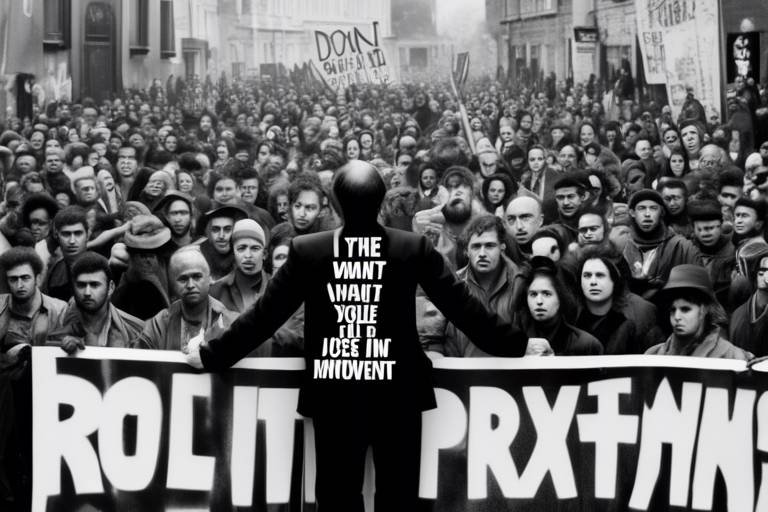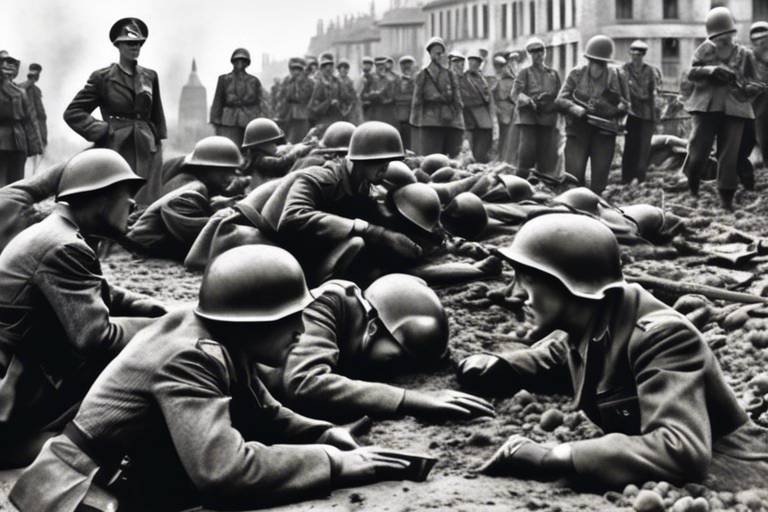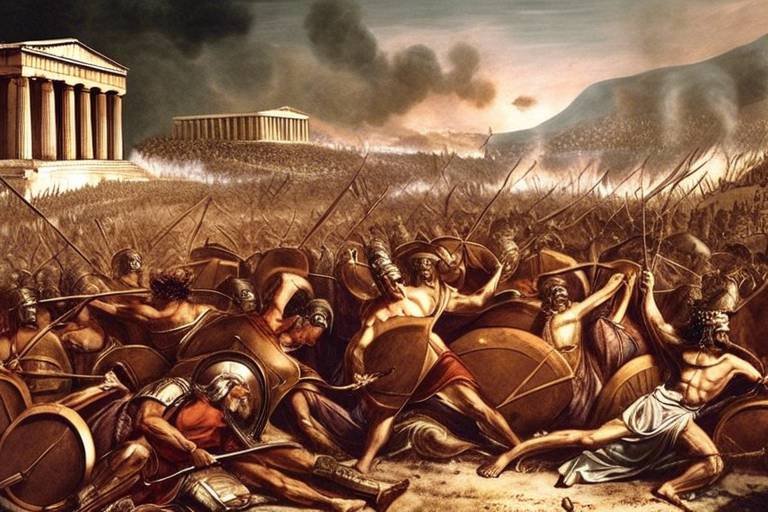The March on Washington - A Defining Moment in Civil Rights
The March on Washington in 1963 stands as a pivotal moment in the history of civil rights, a beacon of hope and unity in the fight against racial discrimination. This iconic event, culminating in Martin Luther King Jr.'s powerful I Have a Dream speech, reverberated across the nation and left an indelible mark on the collective consciousness.

I Have a Dream
Exploring the historical significance and impact of the iconic March on Washington in 1963, a pivotal event in the Civil Rights Movement that culminated in Martin Luther King Jr.'s famous speech.
Understanding the factors and key figures that led to the organization of the March on Washington, including the role of civil rights organizations and leaders in its planning.
Examining the logistical challenges and strategic planning involved in orchestrating a peaceful mass demonstration of such magnitude in Washington D.C.
Detailing the primary goals and demands set forth by the organizers of the March on Washington, such as legislative reforms and an end to racial segregation.
Highlighting the diverse array of individuals and groups who participated in and supported the March on Washington, showcasing the unity and solidarity of the Civil Rights Movement.
Analyzing the immediate and long-term impact of the March on Washington on civil rights legislation, public perception, and the ongoing fight for racial equality in the United States.
Exploring the media's portrayal and coverage of the March on Washington, including the significance of televised broadcasts and newspaper reports in shaping public opinion.
Investigating how the March on Washington reverberated globally, inspiring movements for social justice and civil rights in other countries around the world.
Reflecting on the significance of the March on Washington today, as well as the various ways in which it is commemorated and remembered in contemporary society.
The "I Have a Dream" speech delivered by Martin Luther King Jr. during the March on Washington remains one of the most powerful and enduring speeches in American history. In this iconic address, King eloquently expressed his vision of a future where individuals are judged by the content of their character rather than the color of their skin. The speech resonated deeply with the crowd present that day and continues to inspire generations with its message of hope, equality, and unity.
Stay tuned for some frequently asked questions about the March on Washington and its impact on the Civil Rights Movement.

speech.
One of the most iconic and powerful moments of the March on Washington in 1963 was Martin Luther King Jr.'s I Have a Dream speech. This historic address delivered from the steps of the Lincoln Memorial captivated the crowd and resonated across the nation. In his speech, King eloquently articulated his vision of a future where individuals would not be judged by the color of their skin but by the content of their character. The I Have a Dream speech has since become a symbol of hope, unity, and the ongoing struggle for equality.

Origins of the March
The origins of the March on Washington can be traced back to the deep-rooted injustices and systemic racism that plagued the United States in the 1960s. The Civil Rights Movement, led by prominent figures such as Martin Luther King Jr., sought to address these issues and bring about meaningful change. As tensions escalated and calls for equality grew louder, the idea of a large-scale demonstration in the nation's capital began to take shape.
Civil rights organizations played a crucial role in laying the groundwork for the March on Washington. Leaders like A. Philip Randolph, the head of the Brotherhood of Sleeping Car Porters, and Bayard Rustin, a key strategist in the movement, were instrumental in organizing the event. Their vision was to mobilize a diverse coalition of individuals and groups to demand civil rights reforms and an end to racial discrimination.
The March on Washington was not a spontaneous event but the result of meticulous planning and coordination. Logistics posed a significant challenge, from securing permits for the demonstration to arranging transportation for participants from across the country. Despite the complexities involved, the organizers were determined to ensure a peaceful and impactful gathering in the heart of Washington D.C.
One of the key objectives of the March on Washington was to present a unified front and amplify the voices calling for change. The demands put forth by the organizers included comprehensive civil rights legislation, desegregation of public facilities, and an end to discriminatory practices in employment. The march aimed to pressure the government to address these pressing issues and enact meaningful reforms.
As the momentum leading up to the march grew, a diverse coalition of participants and supporters emerged. People from all walks of life, including activists, clergy, labor unions, and ordinary citizens, came together to show solidarity with the cause. The march became a powerful symbol of unity and collective action in the fight for civil rights.

Logistics and Planning
Organizing the March on Washington was no small feat. The logistics and planning involved in orchestrating a peaceful mass demonstration of such magnitude in the heart of Washington D.C. required meticulous attention to detail and strategic coordination. From securing permits and ensuring crowd control to arranging transportation and facilities for participants, every aspect of the event had to be carefully thought out and executed.
Imagine the challenge of coordinating the arrival of hundreds of thousands of people from different parts of the country, all converging on the nation's capital for a common cause. The logistics team had to account for food, water, medical services, restrooms, and security measures to ensure the safety and well-being of everyone in attendance. It was a massive undertaking that required months of planning and coordination.
Additionally, the organizers had to consider the timing and route of the march to minimize disruptions to the city while maximizing visibility and impact. Strategic decisions were made to ensure that the message of the march was heard loud and clear, both by those in power and the general public. It was a carefully choreographed event aimed at capturing the nation's attention and spurring action on civil rights issues.

Key Objectives
The of the March on Washington were clear and resolute. Organizers aimed to bring attention to the urgent need for legislative reforms to address systemic racial inequality and discrimination in the United States. The primary demand was the passage of civil rights legislation that would guarantee equal rights and protections for all citizens, regardless of race. Another crucial objective was to call for an immediate end to racial segregation in public spaces, schools, and workplaces, advocating for a society where individuals were judged not by the color of their skin but by the content of their character, as famously stated by Martin Luther King Jr. in his iconic I Have a Dream speech.

Participants and Supporters
When delving into the vibrant tapestry of individuals who participated in and supported the March on Washington, one is met with a mosaic of diversity and unity. From civil rights activists to everyday citizens, the March on Washington brought together a multitude of voices under the common banner of equality and justice. Leaders such as Martin Luther King Jr., Rosa Parks, and John Lewis stood shoulder to shoulder with ordinary Americans, creating a powerful tableau of solidarity.
Not only did African Americans play a pivotal role in the March on Washington, but individuals from various racial and ethnic backgrounds lent their support to the cause. The event served as a melting pot of advocacy, where people from all walks of life converged to demand an end to racial discrimination and segregation. This collective gathering underscored the universal resonance of the civil rights movement and highlighted the shared humanity that binds us all.

Impact and Legacy
The of the March on Washington in 1963 reverberated far beyond the streets of Washington D.C., leaving an indelible mark on the course of civil rights history in the United States. The sheer magnitude of the event, with an estimated 250,000 participants, sent a powerful message to the nation and the world about the urgent need for racial equality and justice.
One of the most significant outcomes of the March on Washington was the immediate impact it had on legislation. The pressure generated by the event played a pivotal role in the passage of the Civil Rights Act of 1964 and the Voting Rights Act of 1965, landmark pieces of legislation that dismantled institutionalized racism and discrimination.
Moreover, the March on Washington transformed public perception of the Civil Rights Movement. The peaceful and dignified nature of the demonstration, coupled with Martin Luther King Jr.'s iconic I Have a Dream speech, captured the hearts and minds of people across the nation, galvanizing support for the cause of racial equality.
The legacy of the March on Washington continues to resonate today, inspiring ongoing efforts to combat systemic racism and inequality. The event serves as a reminder of the power of collective action and the importance of standing up against injustice, no matter how daunting the challenge may seem.

Media Coverage
The media coverage of the March on Washington played a crucial role in shaping public perception and disseminating the message of the civil rights movement. Television broadcasts provided a powerful visual narrative of the event, showcasing the massive turnout and the peaceful nature of the demonstration. Newspapers across the country featured headlines and articles highlighting the significance of the march and Martin Luther King Jr.'s impactful "I Have a Dream" speech. The media's extensive coverage helped bring the issues of racial inequality and civil rights to the forefront of national discourse, sparking conversations and debates across the country.

International Reverberations
When it comes to the of the March on Washington, it's fascinating to see how a single event in the United States had a ripple effect around the world. The impact of the march extended far beyond American borders, resonating with people in countries facing their own struggles for equality and justice. The powerful message of unity and peaceful protest transcended national boundaries, inspiring movements for social justice on a global scale.

Reflections and Commemorations
Reflecting on the significance of the March on Washington today, we are reminded of the enduring impact it has had on the Civil Rights Movement and American society as a whole. The March stands as a beacon of hope and a symbol of unity, showcasing the power of peaceful protest and collective action in the face of injustice.
Commemorations of the March on Washington take various forms, from annual events and ceremonies to educational programs and exhibitions. One of the most notable ways in which the March is remembered is through the Martin Luther King Jr. Memorial in Washington D.C., a powerful tribute to the man whose vision inspired the historic event.
Additionally, the "I Have a Dream" speech delivered by Martin Luther King Jr. during the March continues to resonate with people around the world, serving as a timeless call for equality, justice, and unity. The speech's iconic phrases have become ingrained in the fabric of American culture, inspiring generations to strive for a more inclusive and equitable society.
Through reflections on the March on Washington and its legacy, we are reminded of the ongoing struggle for civil rights and social justice. The principles espoused during the event remain as relevant today as they were in 1963, urging us to continue the fight for equality and dignity for all individuals, regardless of race, gender, or background.
Frequently Asked Questions
- What was the significance of the March on Washington?
The March on Washington was a pivotal event in the Civil Rights Movement, serving as a platform for advocating for civil rights legislation and an end to racial segregation. It culminated in Martin Luther King Jr.'s iconic "I Have a Dream" speech, which resonated globally and inspired generations of activists.
- Who organized the March on Washington?
The March on Washington was organized by a coalition of civil rights organizations, including the Southern Christian Leadership Conference (SCLC), the National Association for the Advancement of Colored People (NAACP), and the Congress of Racial Equality (CORE). Key leaders such as A. Philip Randolph and Bayard Rustin played instrumental roles in its planning and execution.
- What were the key objectives of the March on Washington?
The primary objectives of the March on Washington were to advocate for civil rights legislation, desegregation, voting rights, and economic equality for African Americans. The organizers aimed to pressure the government to address systemic racism and inequality through peaceful mass mobilization.
- How did the media cover the March on Washington?
The media coverage of the March on Washington was extensive, with televised broadcasts and newspaper reports reaching a wide audience. The positive portrayal of the peaceful demonstration and the powerful speeches delivered during the event helped garner public support and awareness for the civil rights cause.
- What was the legacy of the March on Washington?
The March on Washington left a lasting legacy on the civil rights movement, leading to the passage of key legislation such as the Civil Rights Act of 1964 and the Voting Rights Act of 1965. It also inspired future generations to continue the fight for racial equality and social justice.



















